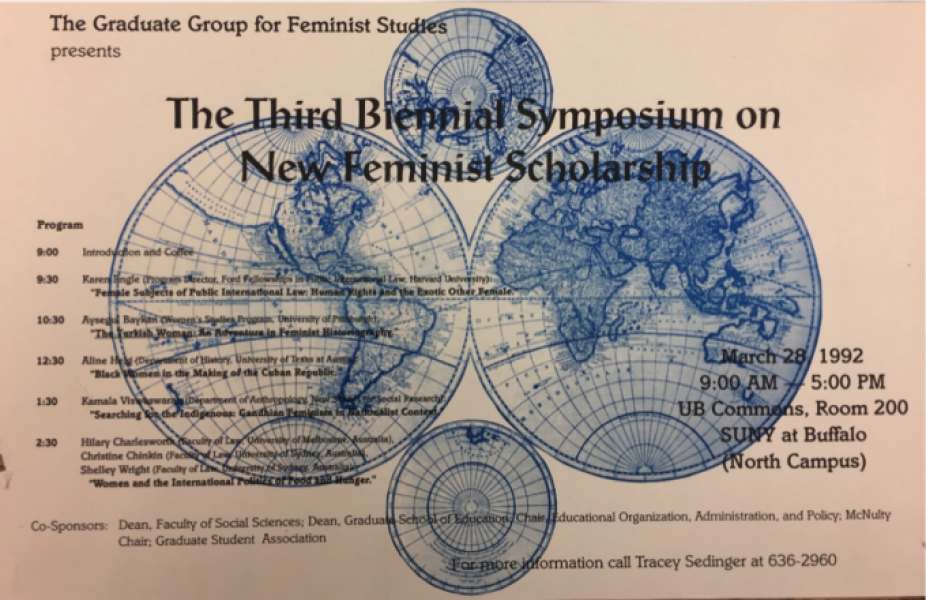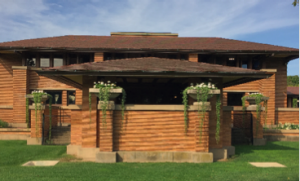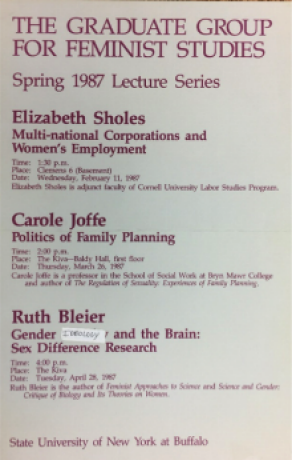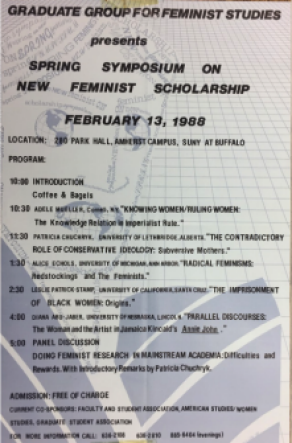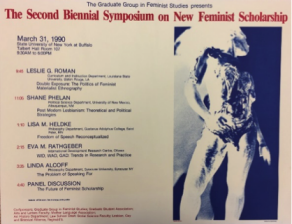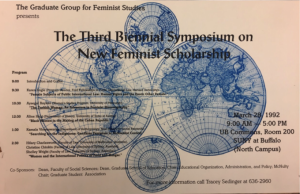History
Founded in 1997, the Institute for Research and Education on Women and Gender promotes scholarship and praxis with the goal of helping to implement gender equality at the University at Buffalo and around the world.
IREWG - The Prequel
Carolyn Korsmeyer's notes from the Graduate Group for Feminist Studies archive
May 13, 2019
The current Institute for Research and Education on Women and Gender, more conveniently referred to as the Gender Institute, has a long history. Here I reflect on its predecessor: The Graduate Group for Feminist Studies, which was established in 1986 and, after several active years sponsoring symposia, film festivals, seminars, and lectures, eventually folded into the Gender Institute in 1997.
Symposium Poster, 1992. This and all subsequent images of Graduate Group for Feminist Studies posters are courtesy of the University Archives, University at Buffalo
Origins:
The GGFS grew out of still earlier groups dedicated to feminist scholarship, which are worth remembering because of the historical depth of research on women and gender that developed in Buffalo. The Women’s Studies Program, founded in 1971 and spearheaded by Elizabeth Kennedy in the American Studies Program, was one of the first such academic units to be established in the US. Moreover, from the late 1970s until about 1993, a loose group called the Buffalo Women Scholars Network, comprising women from several local institutions, met periodically to read and discuss current feminist theoretical works. Back in the day, UB owned the Darwin Martin House, and the Network often met in the drafty remnants of that building, distributing ourselves across Frank Lloyd Wright’s original, elegant, valuable, and surprisingly uncomfortable chairs and couches. When that group began to dwindle, its UB contingent set about to establish a more formal institutional framework to provide a setting for feminist research, education, and outreach programs.
Darwin Martin House today, post-renovation. Jewett Parkway, Buffalo.
The opportunity for this was presented by units called Graduate Groups, which were sponsored by UB’s office of the Vice Provost for Graduate Education with the aim of promoting cross-disciplinary research. In 1985, a group of faculty headed by a sociologist (Ben
Agger), a historian (Ellen DuBois), and a professor from the School of Education (Sheila Slaughter), submitted a plan that would formally bring together feminist researchers from across the university. Even with this first application, the seeds of IREWG were being sown, for the stated long-range goal of the proposed Graduate Group for Feminist Studies was “to lay the groundwork for a Center for Advanced Feminist Research which would enable SUNY/Buffalo to become competitive with such research centers as Rutgers, Wellesley, Brown, and Columbia.” The application was approved by the then Vice-Provost, Donald Rennie, and the following year the GGFS launched its activities.
With its first application, the GGFS had the support of three deans—Arts and Letters, Law, and Architecture and Design, later joined by Social Sciences, Nursing, and Education. (At that time, what is now the College of Arts and Sciences was split into the Faculties of Arts and Letters, Social Sciences, and Natural Sciences and Mathematics.) It quickly became far and away the largest and most diverse of all the Graduate Groups, spanning multiple disciplines and Faculties.
The GGFS kept an active mailing list, produced a regular Newsletter, and compiled a Directory of UB feminist scholars. Annual figures for these products vary, but in 1990 the Newsletter (which was distributed on paper, not a list serve) went out to about 300 people. That year, the Directory listed 84 faculty members who classified their research as including feminist scholarship, and by 1997 that number had grown to 123. The Newsletter usually appeared monthly, and sometimes it was co-produced with the Women’s Studies Program. In 1997, Women’s Studies and the GGFS established a shared web home page to distribute information digitally. In 1990, the GGFS was accepted as a member of the National Council for Research on Women.
Activities:
One of the first things to be established was a series of work-in-progress seminars where both faculty and graduate students could present their research. Lecture series were another obvious activity, and the GGFS sponsored and co-sponsored numerous speakers, some of whom would become luminaries in their fields. Others were already quite well-known, such as art historian Linda Nochlin and artist Faith Ringgold. The latter performed before a large audience at the Albright-Knox Gallery auditorium, and her appearance was co-sponsored by ten academic units. (The amount of co-sponsorship generated by programs of the GGFS is significant, for its own budget was always rather small.) Lecture series in the late 1980s and early 90s explored “Black Feminists and Sexuality”; “Feminist Interpretations of Mass Culture”; and “Around the Lake”—a cooperative venture among feminist scholars in New York and Canada.
In 1988, the GGFS launched a biennial series of symposia on New Feminist Scholarship. Speakers were chosen from applicants—both graduate students and early-career faculty—who responded to a national call for papers, and there were three highly successful such events. A fourth conference was discussed but never came about because by that time graduate groups in general were being phased out.
Feminist scholarship is never entirely divorced from political activism, and for a time members of the GGFS coordinated with the Erie County Commission on the Status of Women to provide research on women’s situations locally. A good deal of programming spanned UB and the surrounding community, including the 1989 forum on “Communities at Risk” that called attention to issues especially pertinent to the lesbian community.
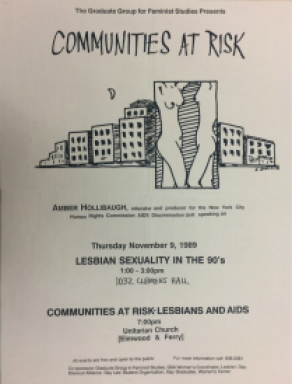
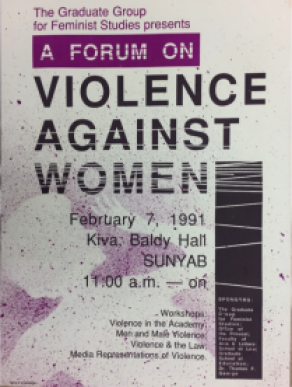
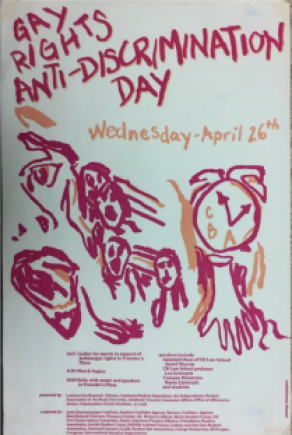
Some of the most successful programming of the GGFS involved film and art festivals, which drew large audiences. One such program was titled Hi, this is Judy: Women Making and Becoming Art, which extended for two and a half weeks in October, 1987. This diverse set of events included an immensely popular all women reggae band, Casselberry and Dupree, whose performance drew an audience of over 500. The estimated attendance overall for Hi, this is Judy was approximately 1,500.
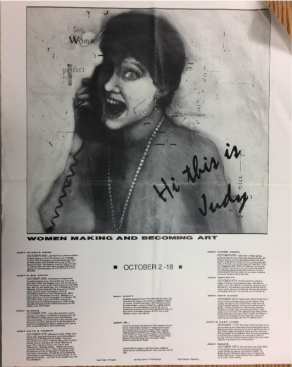
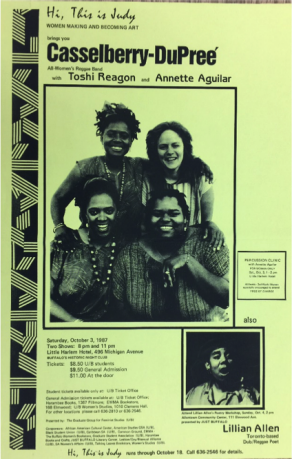
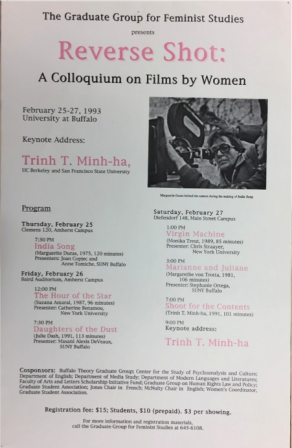
The GGFS co-sponsored and otherwise supported efforts undertaken by faculty whose work included feminist activities and research, such as a multi-year program for an International Women Playwright’s conference beginning in 1988, organized by Anna Kay France from Theatre and English. Several film festivals highlighted works by women cinema artists that dealt with subjects related to gender and social situations in different countries and historical times. In 1993, the festival Reverse Shot brought distinguished filmmaker Trinh T. Minh Ha to give the keynote address.
Bumps in the Road:
The extraordinary breadth of fields that described members of the GGFS signaled both the diversity and vitality of feminist interests and the difficulties that would beset programs that appealed to participants from such different areas. Although annual renewals were always granted by the Vice Provost’s office, complaints began to surface. A repeated grumble concerned how the GGFS deployed the energies of our Graduate Assistant. The GA, who was almost always from a department from Arts and Letters, was responsible for considerable organizing details, many of which involved tasks such as hotel reservations for visiting speakers, locating venues for programs, and the all-important mustering of co-sponsorships to supplement our limited funds. Most of those GAs—along with faculty—pursued such jobs with enthusiasm, understanding that popular events with a feminist agenda do not happen without such on-the-ground efforts. Nonetheless, our knuckles were rapped twice because these students were not assigned research duties that furthered their own degree programs. I suspect that more than one GA agreed that her own work was being occasionally sidelined.
But how does one identify a research project for a student serving a group with such a broad constituency? One that both enhances the education of a particular student, and at the same time serves the interests of scholars from fields as various as architecture, nursing, history, sociology, biology, philosophy, modern languages, law, and art? The fact is, interdisciplinary scholarship is extremely difficult to accomplish, and the label “feminist” cannot by itself unite any project that tries to combine fields of great diversity.
One of the goals of the GGFS was to foster cross-disciplinary teaching as well as research. Joint teaching, however, must accommodate varying schedules and requirements, and it was not always accomplished smoothly. I myself jointly taught a large graduate seminar on Feminism and Postmodernism (that enrolled students from four or five different departments) with colleagues from Art History (Carol Zemel) and English (Claire Kahane). Both Claire and Carol were members of the Faculty of Arts and Letters, whose Dean approved the course for their on-load teaching. But Philosophy was then in the Faculty of Social Sciences, and that Dean decided I should teach it overload. I did so and learned a great deal in the process, but a course taught by three people does not require a third of the effort for each; one should multiply rather than divide the work required.
Despite those complications and occasional tensions, the administration continued to support the GGFS, not only with funds but also by granting us the GA that other graduate groups were losing. Nonetheless, it was clear that the Provost’s office was beginning to redirect funds away from these groups, few of which had managed to garner grants to support their operations, which the UB administration had hoped would eventually underwrite their activities. A set of inquiry letters from the GGFS to granting agencies inquiring about that possibility are preserved in the archives. Virtually all responders noted that their organizations did not support operating expenses at other institutions—something we already knew, but we felt obliged to petition for outside resources anyhow. Several graduate groups folded; a few others became independent centers.
Members of the GGFS kept hoping that a permanent institute for feminist work would come into being, for that, after all, had been the ultimate goal from the start. In 1993-94 a committee of 20-30 faculty members, chaired by Susan McLeer of Psychiatry, began explicit planning for such an institute. Documents from the next three years indicate perseverance on the part of this committee and worry that the administration was slow to take action. Although it took several years of reminding and petitioning, as well as adjusting details regarding the formation of the institute, that goal was finally achieved: The GGFS/Women’s Studies Newsletter from November, 1997, opened with the triumphant headline: Graduate Group for Feminist Studies Incorporated into the Institute for Research and Education on Women and Gender.
Records of most of these activities are housed at the UB archives and are available for perusal. The finding guide for the holdings pertaining to the GGFS can be found at https://findingaids.lib.buffalo.edu/repositories/2/resources/400. Images from the GGFS archive are used here with permission of the UB Archives and should not be copied without further permission. I thank archivist Bill Offhaus for his generous help in locating materials for me to write this brief history.
Carolyn Korsmeyer is Research Professor of Philosophy at UB. Her chief areas of research are aesthetics and emotion theory. Her work on feminist aesthetics appears in Gender and Aesthetics (2004). She is also the author of Making Sense of Taste: Food and Philosophy (1999); Savoring Disgust: The Foul and the Fair in Aesthetics (2011); and Things: In Touch with the Past (2019).
